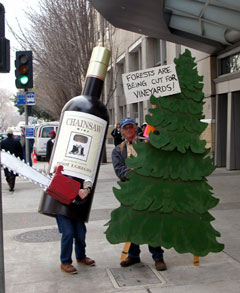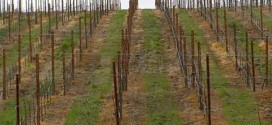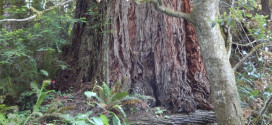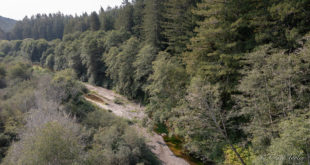 The California Department of Forestry (CDF) has just approved two of the many pending forestland to vineyard conversions in the Annapolis area. Clear cutting is presently taking place on many acres of conversions spearheaded by vineyard entrepreneurs. They hope to profit by permanently scraping an ancient forest ecosystem off coastal hills and planting the bare ground with wine grapes. The CDF approvals of the “Putnam” and “Jones” conversions in Annapolis represent the opening door on a far reaching, serious threat to maintaining water quality, water quantity and biodiversity in north coast watersheds.
The California Department of Forestry (CDF) has just approved two of the many pending forestland to vineyard conversions in the Annapolis area. Clear cutting is presently taking place on many acres of conversions spearheaded by vineyard entrepreneurs. They hope to profit by permanently scraping an ancient forest ecosystem off coastal hills and planting the bare ground with wine grapes. The CDF approvals of the “Putnam” and “Jones” conversions in Annapolis represent the opening door on a far reaching, serious threat to maintaining water quality, water quantity and biodiversity in north coast watersheds.
The deforestation in these plans being approved and those pending is being done without any thorough study of the cumulative effects from all of the existing, pending, and potential future conversions. These planned coastal vineyards are in water scarce areas and utilise large lined reservoirs that prevent natural runoff from entering streams and the river. Evidence is mounting that a neighbouring river to the north, the Navarro, is experiencing greatly reduced summer flow due to the extensive vineyard development in Anderson Valley.
The complex forest ecosystem acts as a sponge that absorbs winter rainfall and releases it slowly over the year to maintain fish, riparian habitat and clean safe water for users such as The Sea Ranch and the town of Gualala. It would seem prudent for these two water companies to be concerned enough about future water availability to join in a call to study this new threat. If conversions continue they might “solve” one of the other threats to the Gualala River watershed: the proposed water-bagging scheme will become a moot point if enough water does not reach the estuary and the existing wells along the river. In addition, a long list of pesticides is regularly used in commercial vineyards. No study exists looking into the effects of this potential chemical cocktail on salmonids and other downstream fauna and users.
Allowing successive conversions is akin to playing Russian roulette with the health of the watershed. Cumulative impacts must be thoroughly considered in any approval process. Data is needed now to quantify the amount of potential acreage that is at risk. This would involve looking at the soil types, microclimate and other factors that are attracting vineyard speculators to the precious, remaining coastal forests.
Concern about these conversions and/or calls for a moratorium and study should be directed to:
Andrea Tuttle
Director California Department of Forestry and Fire Services
1416 Ninth Street
Sacramento, CA 95814
Letters should also be copied to the Sonoma County Permit and Resource Management Department which is updating the General Plan with its control of permitted land uses through zoning.
SCPRMD
2550 Ventura Avenue
Santa Rosa, CA 95403-2829
| This commentary was published in the Independent Coast Observer on October 25, 2002. |
 Friends of Gualala River Protecting the Gualala River watershed and the species living within it
Friends of Gualala River Protecting the Gualala River watershed and the species living within it


